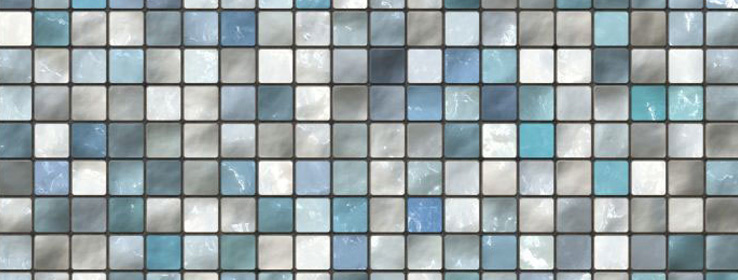Glass tile has beautified buildings for millennia, and as its appeal broadens, so too does the range of ways you can incorporate this stunning material into your designs.
Ancient beginnings
Glass was used in mosaics as early as 2500 B.C., but tiles made of glass weren't introduced until the third century B.C., when Byzantine artists created opaque glass tiles called smalti and used them to decorate walls, ceilings, facades and vaults of churches and public buildings.
Only the very wealthy could afford to apply the material to private residences. This remained the case until the Victorian era, when innovations in mass production made glass tile much cheaper to manufacture and therefore accessible to middle-class homes. In the Art Deco movement of the 1920s, a pigmented structural glass tile (the best-known brand was Vitrolite) gave a slick, modern look to walls on storefronts, train stations, and more.
In the 1990s, further advances to production brought a renewed interest in glass tile, especially in the use of recycled glass to make tiles. Today glass tile comes in myriad shapes, sizes, colors and forms and can be used in virtually any room in the house.
Smalti. The Byzantine tile that's still popular – usually small, colorful and textured.
Clear glass. Adds extravagant color and shine to an interior – but the backing will be visible so application needs to be carefully considered.
Frosted glass. A flatter, more opaque alternative to clear glass.
Bubble glass. Manufactured to trap small air bubbles in the glass to add visual interest.
Crystal. Glass designed to resemble crystal or jewels – best used as an accent so its flashiness doesn't overwhelm a room.
Sintered tile. Made from glass powder, pressed into dies and heated until the particles fuse.
Cast tile. A layered, multicolored tile made from chunks of glass melted together in a mold.
Slumped tile. Glass curved into shapes during firing, resulting in a contoured, patterned surface.
The sky's the limit
The most popular home use of glass tile is in bathrooms and kitchens. From backsplashes and countertops to shower and tub walls, glass offers a strikingly beautiful alternative to other kinds of tile such as ceramic and porcelain. "We're used to seeing square and rectangular tiles, but with glass there are all these round and different-sized shapes where you can create all sorts of designs," says Michael Scott, design director of Robb & Stucky Interiors, Scottsdale, Ariz.
The material isn't limited to bathroom and kitchen uses. There are outdoor applications for glass tile, too. The sides and bottoms of pools can feature stunning, elaborate designs in glass tile. "It adds a sparkle of light," Scott says. "It captures light as no other tile can – it reflects light and gives the appearance of water. That's the primary reason for using [it] in bathrooms, kitchens, swimming pools and spas." It's perfect for water features such as fountains, too, where glass tile can appear delicate, almost ethereal, but is tough enough to withstand the elements. Glass tile can also adorn outdoor benches, house signs and free-standing art installations. "You can be creative, collect different pieces and make a mosaic," Scott says.
Some recent glass tile products are simply dumbfounding in their originality and beauty. Architectural Systems Inc. has created two such products: Butternut Glass, wood veneer less than an inch thick, coated with glass and thin enough for light to shine through; and Fusionstone™, exotic stone with glass permanently fused to the surface to both protect and showcase its natural beauty. Even with standard glass tile, using it in contrast with other materials enhances the appearance of both. "You can use it in combination with ceramic and metal, because it gives you a matte, opaque surface and then the glass adds some sparkle," Scott says. "In a mosaic, use ceramic for negative space and glass for the main image."
Trend USA offers glass wallpaper: mosaic tiles assembled into modules that make it easy to repeat patterns on walls without interruption. The tiles can be applied to both flat and curved surfaces, so they can essentially be used in place of wallpaper.
Bisanzio tile mosaic rugs from Sicis make an even more improbable leap: Tiny, perfectly formed handmade glass tiles, affixed to a flexible surface, create classic rug patterns such as vines and leaves. The durability of glass means the rugs can be placed in entryways and other high-traffic areas, or they can be hung on the wall like tapestries.
Pros and cons of glass
Glass tiles offer a unique look and unmatched shine compared with other materials for floors, walls and countertops. Translucent tiles can add an unusual effect of depth to surfaces that's unlike any other material. Kim Emerson of Kim Emerson Mosaics told Tile Magazine, "Glass has a rich quality that other materials don't have in terms of shininess. It is also really nice because you can see the color all the way through versus other material like ceramic tile."
Glass tiles are also resistant to stains, mildew and allergens. They're easy to wipe clean and do not stain. Their durability is comparable to other wall and flooring materials.
Yet there are some drawbacks to consider before deciding to use glass tile. The shiny surface means that fingerprints and footprints show up more clearly than on duller surfaces, so more-frequent cleaning may be necessary to maintain that smooth gleam. And even though they are hardy, there's some chance glass tiles will get scratched with use over time. "Once it's installed, it's hard to break," says designer Glen Boudreaux of Dallas-based Glen Boudreaux & Associates. "But glass does scratch. So if you put it on the floor, be aware that over time it could become dull and scratched. Keeping it clean helps, because grit and dirt are what cause scratches."
Also, if you're considering the tile for a bathroom or shower floor, keep in mind that glass can feel colder underfoot and can be much more slippery when wet than porcelain or ceramic tiles. "With large tiles, it becomes very slippery and dangerous. So glass tiles on the floor can become a safety problem," Boudreaux says. "Using a mosaic on the floor of a shower makes it easy to create a slope, and the grout between the smaller pieces gives it some grip. But depending on how smooth and polished the surface is, it could still be slippery." Applying a non-slip sealant after installation is one solution, but overall Boudreaux recommends using glass tiles for walls, and limiting its use on floors to accents and borders.
Finally, while glass tile is sturdy once it's installed, the individual pieces can be quite delicate, so many experts recommend using an experienced pro to install them. Scott, however, disagrees: "I installed glass tiles as a border around my swimming pool. I'm not a professional installer, and I found them very easy to use."
Eco-friendly glass
Glass tile can be made from 100 percent recycled post-consumer glass or from "post-industrial" glass: that is, discarded leftover end cuts or broken pieces resulting from production of other glass products. Using recycled material eliminates the energy cost of producing all-new materials, keeps waste products out of landfills and avoids disturbing natural areas to obtain raw material. Also, re-forming glass typically uses less energy than creating glass tiles from scratch. And some environmental benefits are shared by both first-generation and recycled glass tile: It releases zero emissions into the air, is well-tolerated by people with chemical sensitivities and is itself recyclable.
However, glass tile requires higher heat to produce than other floor and wall coverings, though a process called "sintering" exists, which uses less energy than conventional melting. Also, glass tiles – like many kinds of tiles and flooring – are heavy; transporting them uses more energy than the transportation of lighter materials.
So to get the best environmental result, buy 100 percent recycled-glass tiles, and buy them locally so less energy is required to transport them. Look for a local supplier that sells sintered tiles for even more green credibility.
The future looks clear
With glass tile mentioned in many trend reports for 2009, and with its seemingly endless capacity to be creatively re-imagined for more and more purposes, it looks like the versatile material is here to stay. "There's lots more out on the market than there ever was," Boudreaux says. "There's glass tile where they're imbedding lots of things, like wire mesh, which gives it a geometric appearance. There's lots of things being done to glass that make it an incredible product to use." Scott agrees: "The future of glass tile is huge because it's recycled, and there are so many choices – I think the ideas and the ways to use it are limitless."
For more information:
- About Glass Tile
- Cactus Stone and Tile
- Decorating With Glass Wall Tile
- Glass Tile Flooring
- Tile Mosaic Rug from Sicis, featured in Trendir Home Decorating Trends Magazine
- New Post-Consumer Recycled Glass Mosaic Tile Just Like Wallpaper featured in Jetson Green
Glass Tile Inspirations for Kitchens and Baths by Patricia Hart McMillan and Katharine Kaye McMillan. (Schiffer Publishing, 2006)










